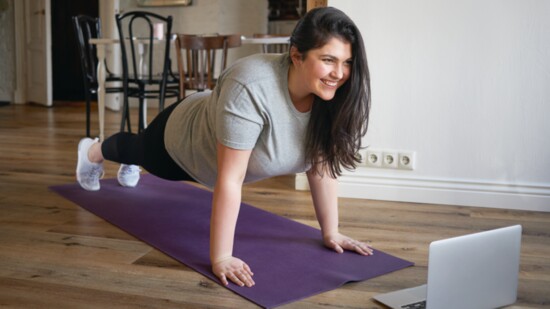What if we told you that you could burn off a little fruitcake and a whole lot of eggnog while staying perfectly cozy at home? Winter in Minnesota definitely presents challenges for staying active. What will work for you? What do you need? Your feet go where? As the holiday hangover commences, we thought it was time for some inspiration, a little nudge to help keep that heart pumping when all it really wants to do is sit and binge-watch The Office. We talked with Grant DeWitt, Head Cross Country and Track and Field Coach at Crown College, about home workouts and why it’s not really about the exercise but more about finding what aligns with you and your lifestyle, making it easier to confidently show up for yourself day after day.
What are some key exercises that can be done at home?
It’s easy to access 10-20 minute bodyweight exercises at home, but it can be very challenging to follow through and actually DO those workouts. I’d recommend finding the simplest routines that require no equipment and then committing, at first, to doing that routine 1-3 times a week. Luckily, some apps offer free video routines where you can select the workout type, duration, and emphasis. I would recommend the Nike Training Club. The nice part about an app like this is that it demonstrates the sequence and then coaches you through the movement to help you improve. Once you’ve found one you like, try building it into your schedule a few days a week!
What are your favorite cardio workouts that call for little to no equipment?
As a former track and cross country athlete, I am biased toward running as my favorite cardio. There are so many trails to explore in this area, especially in places like Carver Park Reserve or the Dakota Rail Trail. Running is simple, can be done at any pace, is a great way to socialize with others, and you don’t have to look amazing or have perfect form. The most important thing is to have grit and consistently show up. Other easy cardio workouts include jumping rope, walking stairs, and bodyweight HIIT exercises.
What are some routines suitable for beginners versus advanced athletes?
Often, beginners who want to start working out more will end up doing too much too soon and feel extremely sore or hurt themselves. My advice is to space out your workouts and ensure that what you start with is doable. For example, a person training to do a 5k but hasn’t run in years would likely not be able to run a full 5k without stopping – they would need to slowly build up their stamina. The biggest difference between beginner and advanced athletes is the amount and intensity of training and the consistency. Advanced athletes are typically prepared for intense workouts 5-7 times a week, while beginner athletes might aim for less intense workouts 2-4 times a week.
What are the biggest benefits of maintaining a routine during the colder months? How would you encourage people to stay committed?
A great way to stay committed to working out during the winter is to get plugged in with other people. Whether that means joining a gym, showing up to a workout class, or joining an online community where you work out together, meeting with people and gathering to do an exercise is one of the best ways to hold yourself accountable and avoid burnout. There are so many options across the West Metro area, so try out different gyms, studios, leagues, or classes and find what’s best for you. You can also try picking up a new sport, like snowshoeing or Nordic skiing, during the winter. Carver Park Reserve in Victoria has groomed Nordic trails that would be a great option for trying something new.
How can people easily set goals and track their progress while working out at home?
One of the best ways to set goals or track progress is by signing up for competitions or creating some with friends, family, or co-workers. Even the friendliest competition will help you push yourself to improve. Once you’ve identified an area you’re passionate about, set a realistic benchmark for how much improvement you’d like to see in a certain amount of time.
